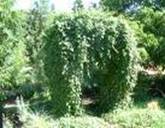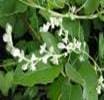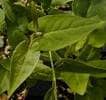| Kingdom | Plantae |
| Division | Magnoliophyta |
| Class | Magnoliopsida |
| Order | Caryophyllales |
| Family | Polygonaceae |
| Genus | Polygonum |
| Species | P . multiflorum |
| Binomial name | Polygonum multiflorum |
Other Common Names:
The other common names for the Chinese climbing knotweed, Chinese cornbind, Chinese flowery knotweed, Chinese knotweed, fo ti, fo-ti-tient, fo-ti root, foti, he shou wu (Chinese), heshouwu (Chinese), ho shou wu (Chinese), Hoshouwu (Chinese) and Tuber Fleeceflower.
History
Chung Yun, a famous Chinese herbalist who reportedly lived to be 256 years old, used Fo-Ti on a daily basis. This herb is thought to have been responsible for both his long life and his legendary sexual prowess, (he was said to have had 24 wives). In another Chinese legend Fo-ti was thought to be responsible for returning natural black colour to a previously gray-haired man- He Shou Wu means "black haired Mr. He." Modern research indicates that this herb contains an alkaloid that has rejuvenating effects on the nerves, brain cells and endocrine glands.

There is however an earlier record of Bryonia dioica from Columbia County (1972) which may in fact have been B. alba. Since the seeds of this species are spread by birds, it has spread extremely rapidly and is now common in Whitman, Garfield, and Columbia counties, as well as being reported for Idaho and Montana. The English and Greek names refer to its quick growth, a feature that one may readily observe for oneself in spring, although it should not be restricted to this plant.
Description
Fo ti is a perennial flowering vine that reaches heights of 3-6 ft (0.97-1.8 m).The root has a sweet and slightly bitter taste. The smooth branching stems are reddish with oval leaves. The thick tuberous rhizomes a somewhat woody, and may weight over 6 pounds


Fo ti is a scandent perennial herb, with thick rhizomes. Stems are much elongate, branched, 1-2 m tall. Leaves of fo ti are alternate, simple, ovate-cordate, 3-4.5 cm long, 2.5-4.5 cm wide, short-acuminate and glabrous.Petioles is about 1-5 cm long but however sheaths are rather short. Spikes branched, terminal, paniculate. Flowers are greenish white, small in slender panicles, 2 mm long. Fruit an achene, 3-angular, with 3 wings, entirely enclosed by sepals, 7-8 mm long.
Range
Fo-ti is a plant native to China, where it continues to be widely grown. It also grows extensively in Japan and Taiwan but can be cultivated in many regions, including parts of North America.
Habitat
Fo ti is generally seen in mountain thickets. It is also seen along the banks of streams and in valley shrub thickets. The plant prefers acid, neutral and basic soils. It can grow in semi-shade or no shade. It requires moist soil.
Cultivation
Propagation of the he shou wu is carried out using the seed stocked from harvested plants, the root division method of cultivation is also used during the spring, and the plant is also propagated from stem cuttings during the summer months. Growing plants need a lot of protection from the cold during the winter months, and growth is best in well fertilized soil. Drying of unearthed roots from three to four year-old plants is carried out during the autumn months. Seeds are sown in a spring in a cold frame. Germination is usually free and easy. When they are large enough to handle, prick the seedlings out into individual pots and plant them out in the summer if they have reached sufficient size. If not, over winter them in a cold frame and plant them out the following spring after the last expected frosts. Division in spring or autumn. Very easy, larger divisions can be planted out direct into their permanent positions. We have found that it is better to pot up the smaller divisions and grow them on in light shade in a cold frame until they are well established before planting them out in late spring or early summer.
Parts Used

The root is collected in the autumn and used both
in the fresh and dry state for its commercial and medicinal purposes.
Flowering Season
The cream or the tan coloured flowers are delicate and they appear from September through October.
Pests and Diseases
Fo ti root is not affected by any major pests and diseases. Occasionally it is been affected by aphids and powdery mildew.
Medicinal Applications
• Externally they are used to treat ringworm bleeding wounds and sores.
• It stimulates a portion of the adrenal gland and helps to detoxify the body.
• It is also indicated to boost the immune system and increase sexual vigour.
• The lectins in processed fo-ti may affect fat levels in the blood, helping to prevent or delay heart disease by blocking the formation of plaques in blood vessels.
• It is said to restore vitality and virility working especially on the liver and the reproductive urinary and circulatory systems.
• Fo-ti has been used for centuries as an anti-aging tonic.



• The herb is also used to lower cholesterol and blood pressure and restore from exhaustion.
• The roots are taken internally in the treatment of menstrual and menopausal complaints constipation in the elderly swollen lymph glands and high cholesterol levels.
• It has also been employed as a remedy for insomnia stomach upset and diabetes.
• Fo ti has also been used traditionally in Chinese medicine for non-acute malaria, for lowering cholesterol, and for nervous disorders.
• It is taken internally in the treatment of insomnia and neurasthenia whilst it is applied externally to ringworm.
• Fo-ti is used to treat premature aging, weakness, vaginal discharges, numerous infectious diseases, angina pectoris, and impotence.
• The leaves and the seeds can be eaten raw or cooked.

A Tang dynasty legend about a man named He Shou-wu is the basis for the common name of this member of the bindweed family. He Shou-wu was credited for remarkable vigour, youthfulness and fathering of many children. During the time of the Tang dynasty, a Chinese legend about a man named He Shou-wu, who became depressed because he had no children and was impotent. he drank himself into a supor and passed out on a mountainside.
Apon awakening, he saw two intertwined herbs growing next to the spot where he lay. He dug up the root and took it to an old village herbalist, who told him it had fabulous restorative powers. He made a decoction of the root and started drinking it everyday. Legend has it that over the next 10 years he fathered several children, his hair never turned grey, and he lived to be 130 years old. Since that time this Chinese member of the bindweed family has been known as He Shou-wu.